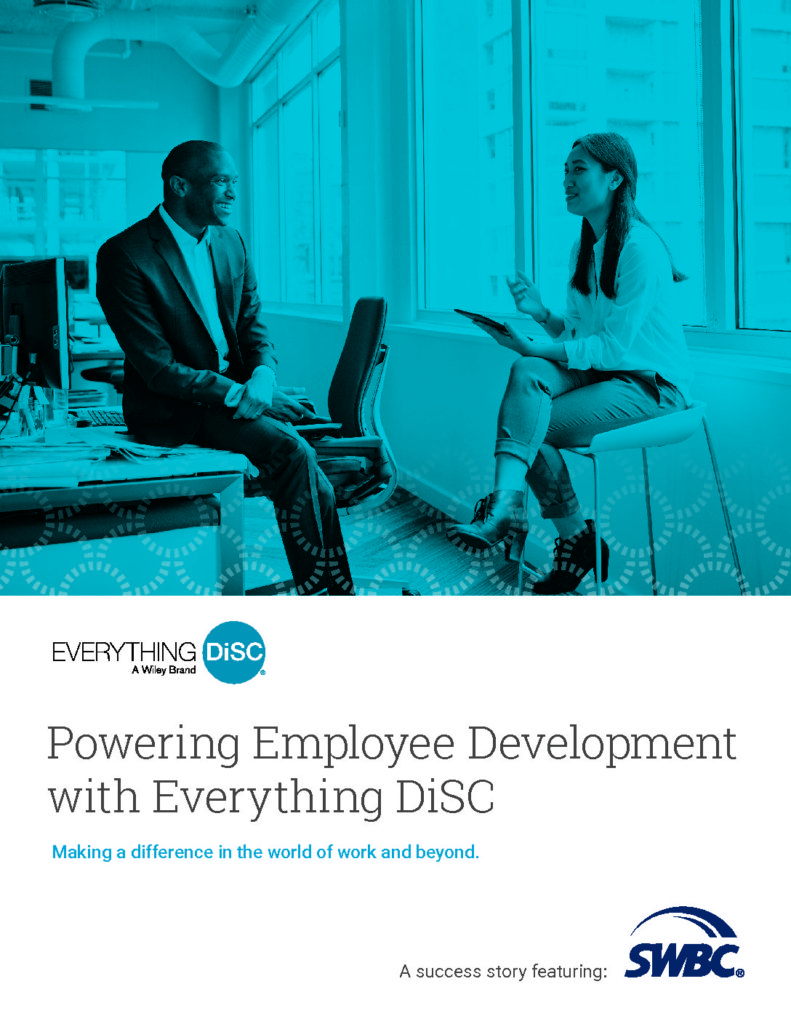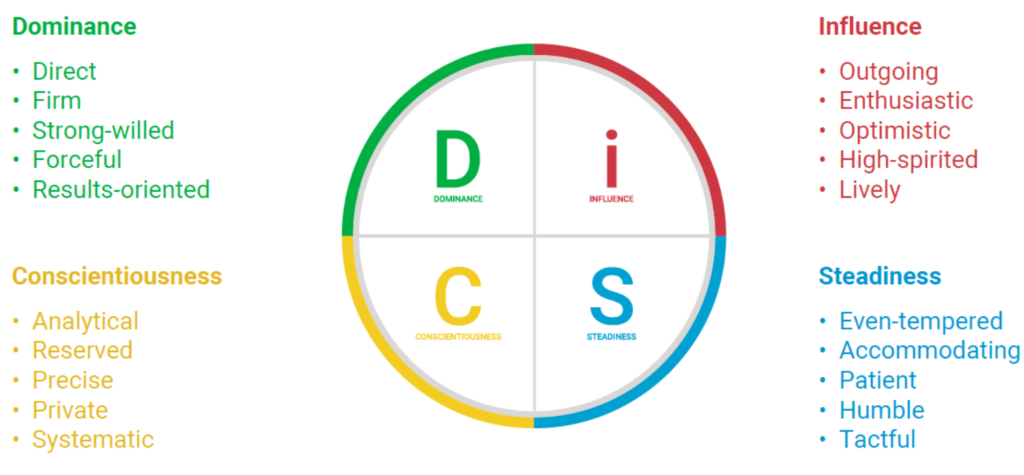Self-awareness is the greatest gift we can give ourselves. Understanding yourself and others helps improve our internal dialogue and communication with others, resulting in building better, solid relationships. The Everything DiSC Assessment (also known as the DiSC personality test) is a tool to help you gain insight into your natural behavioral style and how it affects how you interact with others.
What is the DiSC Personality Assessment?
DiSC is a behavioral assessment tool based on four primary behavioral styles: Dominance, Influence, Steadiness, and Conscientiousness. These styles are represented by the DiSC model, which measures an individual’s tendencies to lean towards certain priorities, such as achieving results, creating harmony or analyzing details. It gives us a visual way of understanding of where we tend to focus our energy and how we can make bigger stretches in areas we are not so comfortable in.
The DiSC Assessment provides a detailed analysis of your behavioral tendencies, preferences, and communication style. The results can help you identify your strengths, weaknesses, and opportunities for growth. It helps you improve on your communication skills, work more effectively with others, and achieve tremendous success in your personal and professional life. Although the tool is intended for professional development and cultivating workplace relationships, don’t be surprised to see how this work spills over in the personal realm as well!
Benefits from the DiSC Personality Assessment

Improved Communication
The DiSC Personality Test helps individuals understand their natural communication style and provides insights into how they can adjust their style to communicate more effectively with others. This can improve communication and reduce misunderstandings, leading to stronger relationships and greater success.
Better Teamwork
By understanding their own DiSC style and the styles of others, team members can work more effectively together. This can lead to better teamwork, increased productivity, and a more positive work environment.
Increased Self-Awareness
The DiSC assessment helps individuals gain insight into their natural tendencies and preferences. This increased self-awareness can lead to personal growth and development, as individuals learn to recognize their strengths and weaknesses and work on areas for improvement.
Enhanced Leadership
Leaders who understand their own DiSC style and the styles of their team members can adjust their leadership style to better meet the needs of their team. This can improve employee engagement, productivity, and overall organizational success.
Understanding the Everything DiSC model
At the heart of the DiSC model is the understanding that every person has a unique blend of four primary styles. These styles are not inherently better or worse than one another. Instead, they offer valuable differences that, when harnessed, can lead to better workplace communication and healthier organizations. Sounds simple, right? While the concept is straightforward, it’s anything but simplistic.
When the first DiSC Classic paper profile assessment became available, it was recognized by its signature lowercase “i” in DiSC. After ninety years, they’ve continued to evolve with modern technology, now offering online assessments that utilize adaptive testing techniques and sophisticated algorithms for the most accurate results possible. Moreover, the Everything DiSC personality assessment includes personalized feedback for specific roles, such as leaders, managers, and salespeople. The end product is a practical and actionable narrative that’s easy to remember and apply.
How the Everything DiSC Personality Assessment works:
Step 1: Complete the DiSC Personality Assessment
The first step in the DiSC assessment process is to complete an online questionnaire. The assessment typically takes 20-25 minutes to complete and consists of multiple-choice questions.
The questions are designed to measure your natural tendencies in four key areas: Dominance, Influence, Steadiness, and Conscientiousness. The assessment will provide a detailed report outlining your primary DiSC style and how it affects your behavior.
Step 2: Review Your Results
Once you’ve completed the assessment, you’ll receive a detailed report that outlines your behavioral tendencies and communication style. The report will provide insights into your strengths, weaknesses, and opportunities for growth.
The report will also provide tips and strategies for working more effectively with colleagues with different DiSC styles. For example, if your primary style is Dominance, the report may suggest that you need to work on your listening skills when communicating with certain individuals who have a Steadiness or S style.
Step 3: Apply Your Knowledge to improve how you communicate using the DiSC Personality Assessment results
The final step in the DiSC assessment process is to apply your knowledge to improve your communication and relationships with others. Armed with the insights from your assessment report, you can develop strategies for communicating more effectively with individuals with different DiSC styles.
For example, suppose you have a Dominance style and are working with an individual with a Conscientiousness style. In that case, you may need to slow down your communication and provide more details to ensure the individual fully understands your message.
The Vertical and Horizontal Dimensions of Human Behavior
Human behavior can be described by two dimensions in DiSC, a model that has four styles. These two dimensions represent independent constructs that reflect essential aspects of human nature.
The first dimension, known as the Everything DiSC Vertical Dimension, indicates the level of activity from thoughtful to active. Those at the top of the circle tend to be assertive, bold, and dynamic, while those at the bottom are often described as methodical, careful, and calm.
The second dimension, known as the Everything DiSC Horizontal Dimension, ranges from accepting to questioning. People on the left side of the circle are often skeptical, objective, and focused on logic, while those on the right are more receptive, agreeable, and empathetic.

The Four Quadrants of the DiSC model
The DiSC model is a simple yet powerful model that describes four basic behavioral styles: D, i, S, and C, and serves as the foundation for each distinct Everything DiSC application.
D: Dominance
i: Influence
S: Steadiness
C: Conscientiousness
These are defined as: D for Dominance, i for Influence, S for Steadiness, and C for Conscientiousness. Those with a D style are direct and forceful, while those with an i style are outgoing and lively. Those with an S style are gentle and patient, and those with a C style are analytical and precise.
However, these styles do not exist in isolation. Instead, they blend into one another the way colors blend on a color wheel. This means that there are actually 12 unique DiSC styles, each with its own designated zone on the map. These blends are important to understand, as someone with a Di style may have different personality traits than someone with a D style, despite sharing some similarities.
It’s essential to use appropriate language when discussing DiSC styles. Rather than labeling someone as a “C” or any other style, we refer to them as “a person with the C style,” for example. This helps avoid pigeonholing and allows for a more nuanced understanding of each person’s traits.
Overall, the DiSC assessment can provide valuable insights into communication preferences and tendencies. By understanding the various styles and their blends, we can communicate more effectively with others and build stronger relationships.
Concluding Thoughts
In conclusion, the DiSC assessment is a powerful tool for improving communication, building strong relationships, and achieving greater success in both personal and professional life. By understanding your natural tendencies and communication style, you can develop strategies to work more effectively with individuals who have different DiSC styles.
CLICK HERE to learn how a DiSC assessment can help you, your teams and organization build better relationships through their communication and achieve their mutual goals.
